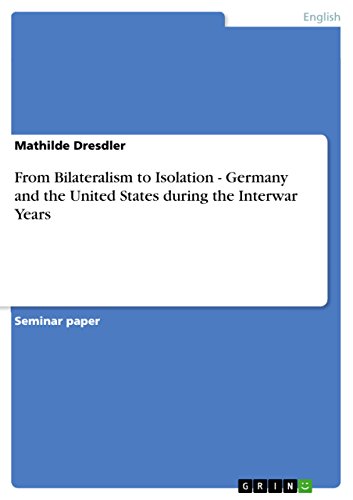From Bilateralism to Isolation - Germany and the United States during the Interwar Years - Softcover

"synopsis" may belong to another edition of this title.
- PublisherGrin Verlag Gmbh
- Publication date2011
- ISBN 10 3640900685
- ISBN 13 9783640900688
- BindingPaperback
- Number of pages28
Buy New
Learn more about this copy
Shipping:
US$ 24.67
From Germany to U.S.A.
Top Search Results from the AbeBooks Marketplace
From Bilateralism to Isolation - Germany and the United States during the Interwar Years
Book Description Taschenbuch. Condition: Neu. This item is printed on demand - it takes 3-4 days longer - Neuware -Seminar paper from the year 2010 in the subject American Studies - Culture and Applied Geography, grade: 2,0, Dresden Technical University (Anglistik, Amerikanistik), course: European- American Relations, language: English, abstract: After the peace of Paris in 1918, Germany and America gradually enhanced and improved their relationship. In 1921, the U.S. and Germany made a bilateral peace and diplomatic relations commenced. The trade agreement of 1923 could be considered as a confirmation of parallel interests and a well- working relationship. America provided Germany with loans to cure the German economy after the hyperinflation. Furthermore, the U.S. aimed to support the establishment of a healthy economy to help Germany enable to pay reparations and to have a market for its exports. Not all Germans, however, embraced the modernism pushed by America through their support. During the Weimar Years, the United States has assisted Germany in all crucial questions referring to reparations, reorganization and reintegration in Europe.A multiplicity of issues has worsened the relationship in the 1930s. The United States and Germany could not agree in terms of disarmament, trade agreements and debts resulting from Dawes Plan loans and Austrian liabilities. Conferences to stabilize the situation and the peace in Europe failed. During his first years in office, the 'Führer' had tried to compromise with America. However, he increasingly emancipated from the Allies and the Treaty of Versailles by making his own decisions regardless to the other nation's opinion. The Neutrality Laws of 1935 constituted a relative freedom of decisions for Hitler. In spite of American neutrality, Roosevelt commented on Hitler's decisions and aggressive foreign policy from 1937 onwards. This was also the turning point for the Nazis; articles in the BIZ, a newspaper being taken away from the Jewish owners and was now a Nazi institution, turned from neutral and positive comments on the New Deal to a hostile hate campaign (Junker, 1997: 246).To bring matters to a head, ambivalence is obviously the best description of German- American relations in the interwar years. Fears, hopes, and interdependences shaped mutual perceptions during this period. From the first encounters after the First World War, to a special bilateral relationship in the 1920s, Germany and America had parted in the 1930s. Interestingly, both were developing toward isolation. The United States because of movements of isolationists, and Germany was isolating itself through its aggressive foreign policy. The America, however, got out of their isolation in 1937/1938. Germany only in 1945- defeated and destroyed. 28 pp. Englisch. Seller Inventory # 9783640900688
From Bilateralism to Isolation - Germany and the United States during the Interwar Years
Book Description Taschenbuch. Condition: Neu. Druck auf Anfrage Neuware - Printed after ordering - Seminar paper from the year 2010 in the subject American Studies - Culture and Applied Geography, grade: 2,0, Dresden Technical University (Anglistik, Amerikanistik), course: European- American Relations, language: English, abstract: After the peace of Paris in 1918, Germany and America gradually enhanced and improved their relationship. In 1921, the U.S. and Germany made a bilateral peace and diplomatic relations commenced. The trade agreement of 1923 could be considered as a confirmation of parallel interests and a well- working relationship. America provided Germany with loans to cure the German economy after the hyperinflation. Furthermore, the U.S. aimed to support the establishment of a healthy economy to help Germany enable to pay reparations and to have a market for its exports. Not all Germans, however, embraced the modernism pushed by America through their support. During the Weimar Years, the United States has assisted Germany in all crucial questions referring to reparations, reorganization and reintegration in Europe.A multiplicity of issues has worsened the relationship in the 1930s. The United States and Germany could not agree in terms of disarmament, trade agreements and debts resulting from Dawes Plan loans and Austrian liabilities. Conferences to stabilize the situation and the peace in Europe failed. During his first years in office, the 'Führer' had tried to compromise with America. However, he increasingly emancipated from the Allies and the Treaty of Versailles by making his own decisions regardless to the other nation's opinion. The Neutrality Laws of 1935 constituted a relative freedom of decisions for Hitler. In spite of American neutrality, Roosevelt commented on Hitler's decisions and aggressive foreign policy from 1937 onwards. This was also the turning point for the Nazis; articles in the BIZ, a newspaper being taken away from the Jewish owners and was now a Nazi institution, turned from neutral and positive comments on the New Deal to a hostile hate campaign (Junker, 1997: 246).To bring matters to a head, ambivalence is obviously the best description of German- American relations in the interwar years. Fears, hopes, and interdependences shaped mutual perceptions during this period. From the first encounters after the First World War, to a special bilateral relationship in the 1920s, Germany and America had parted in the 1930s. Interestingly, both were developing toward isolation. The United States because of movements of isolationists, and Germany was isolating itself through its aggressive foreign policy. The America, however, got out of their isolation in 1937/1938. Germany only in 1945- defeated and destroyed. Seller Inventory # 9783640900688

